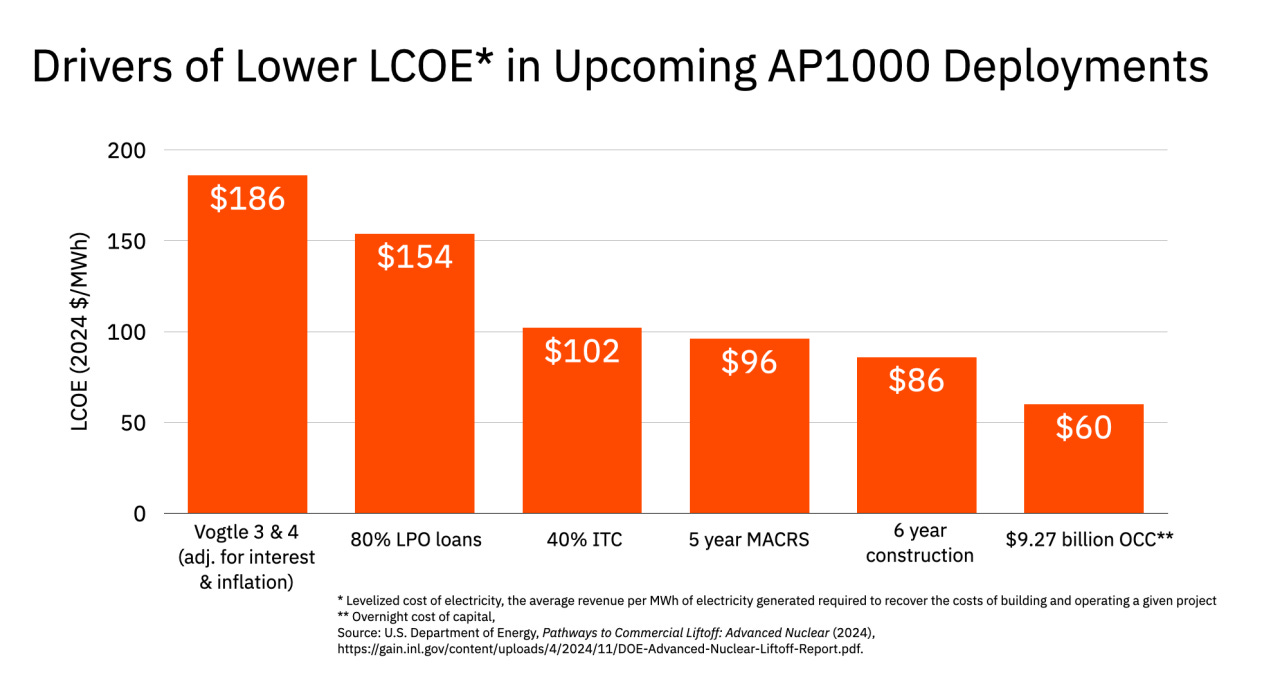We Need More AP-1000s
My conversation with Sec. Chris Wright and our new white paper on fleet-scale nuclear
Last week, I had the great pleasure of interviewing Energy Secretary Chris Wright at the Foundation for American Innovation’s American Innovation Gala. We discussed the lessons he’s learned in his move from Liberty Energy CEO to Energy Secretary, his vision for American energy dominance, and some of his biggest wins at DOE. Unsurprisingly, nuclear featured high on his list—especially nuclear financing.
Wright explained that the DOE’s bank, the Loans Program Office, has “a lot of money at low interest rates” ready to lend to “credit-worthy borrowers.”
I completely agree with Sec. Wright. In fact, FAI Non-Resident Senior Fellow Madi Hilly and I just published a white paper making the case for a fleet-scale build of AP-1000s via the LPO. We walk through the case for big reactors, the grisly history of the first AP-1000 builds, the financing available for fleet-scale AP-1000s, and additional policy levers we could pull to support the build.
For the record, the LPO is a highly efficient lender. It has over $200 billion to lend to new nuclear. President Trump, in one of his executive orders, tasked the DOE with “prioritiz[ing] work with the nuclear energy industry to . . . have 10 new large reactors with complete designs under construction by 2030” in “order to maximize the speed and scale of new nuclear capacity.” The LPO is the vehicle for achieving this goal.
Westinghouse’s AP-1000, which debuted at Vogtle in Georgia, is the only reactor that both meets those criteria and that America has experience building. We need to build more of them, especially since the AP-1000 boasts some serious technical advantages.
By repping out AP-1000s, we can drive down the construction times and costs through economies of repetition. With financing from the LPO and the Investment Tax Credit, there has never been a more conducive environment for large nuclear builds in America. But we can do more!
Here are three other levers to pull in order of importance:
Allow “Double Dipping.”
The LPO’s ability to lend is encumbered by the “denial of double benefits” clause in the Inflation Reduction Act. Essentially, the clause bars the LPO from lending to successive portions of a project—“for example, a long-lead-items loan followed by construction-stage project financing.” This inhibits the LPO’s efficiency as a lender.
In our new paper, we argue that Congress should “amend the IRA’s ‘denial of double benefits’ provision as it applies to Title XVII. At a minimum, Congress should clarify that (1) multiple LPO guarantees for distinct phases, tranches, or scopes of the same nuclear project are permissible so long as the aggregate guaranteed amount does not exceed 80 percent of eligible project costs and (2) the restriction does not apply to projects with federal offtake agreements below a specified share of the nameplate capacity of an individual project or project portfolio.”
Raise the Tennessee Valley Authority’s debt cap.
The TVA is the largest public power entity in America. It could become a powerhouse AP-1000 builder, but its debt cap has been set at $30 billion since the 1970s. As we write, “Pegging the TVA’s debt cap to even half of inflation would more than double its debt cap to $67 billion. The TVA, as an expression of the executive branch’s will, could then commit to an AP-1000 buildout.” To do this, Congress must lift its debt cap.
Establish Regional Consortia.
States could also play a role by forming consortia to welcome new AP-1000s. We write, “States could convene meetings with their respective utilities to iron out a preliminary agreement on the AP-1000 as a chosen reactor type, deployment queueing, offtake for power, and so on. Such an approach could be particularly helpful for regions with a less robust history of nuclear power operations, where siting and offtake opportunities are less established and thus less known.”
There’s more states can do, of course. My colleague at FAI, Sam Roland, has just updated our State Permitting Playbook to help states improve their permitting laws. He’s also working on a state nuclear playbook, which will come out soon.
America needs more Industrial Cathedrals. The suite of policy tools we have at hand are truly revolutionary. As Wright said at our gala, “I’ve heard about the nuclear renaissance for 20 years. We are all in to make it happen.”
Let’s build.





